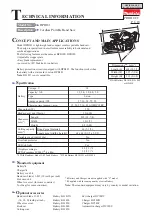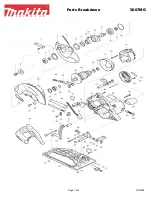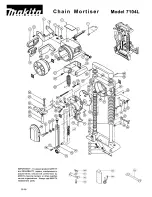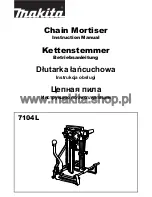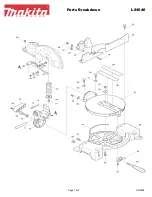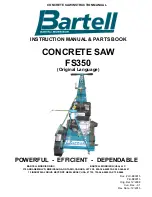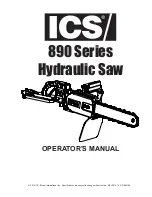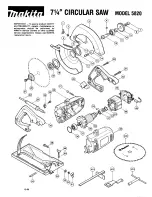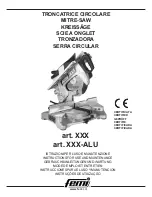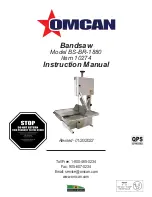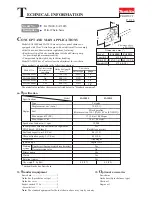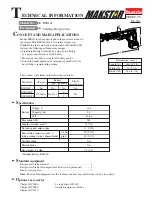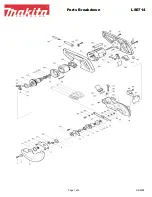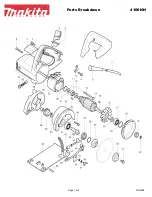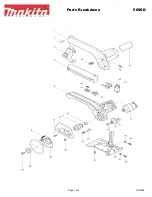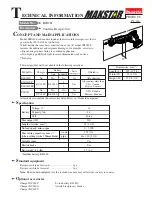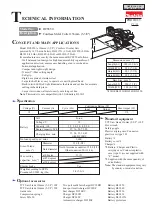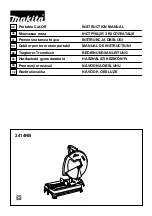
No intente retirar el material de corte
cuando la hoja se esté moviendo.
Verifique que la protección inferior se
cierre bien antes de cada uso.
No ponga la sierra en funcionamiento si la
protección inferior no se mueve
libremente y se cierra instantáneamente.
Nunca sujete ni ate la protección inferior
en la posición abierta. Si la sierra se cae
por accidente, la protección inferior
puede doblarse. Levante la protección
inferior solamente con la Palanca para
levantar la protección inferior y asegúrese
de que se mueva libremente y no toque la
hoja ni ninguna otra pieza, en todos los
ángulos y profundidades de corte.
Verifique el funcionamiento del resorte
de la protección inferior. Si la protección
y el resorte no están funcionando
correctamente, se les debe realizar un
servicio antes de usarlos. Puede que la
protección inferior funcione con lentitud
debido a piezas dañadas, depósitos de
goma o una acumulación de desechos.
Desenchufe la herramienta. Retire la
hoja periódicamente, limpie las
protecciones superior e inferior y el
área del núcleo con keroseno y séquela
con un paño, o límpiela con aire
comprimido.
La protección inferior deberá retirarse
manualmente solamente para cortes
especiales como “Cortes de bolsillo”
y “Cortes compuestos”. Levante la
protección inferior con la Palanca para
levantar la protección inferior. Tan
pronto como la hoja se introduzca en el
material, se debe liberar la protección
inferior. Para todas las demás
operaciones de corte, la protección
inferior debe funcionar
automáticamente.
NUNCA sostenga una pieza que está
cortando en sus manos ni sobre sus
piernas. Es importante apoyar el
trabajo correctamente para minimizar
la exposición corporal, el atascamiento
de la hoja o la pérdida de control.
CAUSAS Y PREVENCIÓN DEL
CONTRAGOLPE POR PARTE DEL
USUARIO:
El CONTRAGOLPE es una reacción
repentina de una hoja de sierra
mordida, atascada o mal alineada,
provocando que una sierra fuera de
control se levante y salga de la pieza de
trabajo hacia el operador.
Cuando la hoja esté mordida o atascada
firmemente por la entalla o ranura de
corte, cerrándose, la hoja se parará y la
reacción del motor impulsará la unidad
rápidamente hacia el operador.
Si la hoja se tuerce o se desaliña en el
corte, los dientes del borde posterior
de la hoja pueden perforar la superficie
superior de la madera provocando que
la hoja se zafe de la entalla y salte
hacia el operador.
El CONTRAGOLPE es el resultado de un
mal uso de la herramienta y/o de
procedimientos o condiciones de
operación incorrectos y puede evitarse
tomando las precauciones necesarias
que se proporcionan a continuación:
1. Sostenga la sierra con firmeza con
las dos manos y posicione su cuerpo
y brazo para permitirle resistir las
fuerzas de CONTRAGOLPE. El
operador puede controlar las
fuerzas de CONTRAGOLPE si toma
las precauciones necesarias.
2. Cuando la hoja se atasque, o cuando
se interrumpa el corte por algún
motivo, libere el gatillo y sostenga la
sierra sin moverla sobre el material
hasta que la hoja se detenga por
completo. Nunca intente retirar la
sierra del trabajo ni tirar la sierra
hacia atrás mientras la hoja esté en
movimiento o puede haber un
CONTRAGOLPE. Investigue y tome
acciones correctivas para eliminar la
causa del atascamiento de la hoja.
3. Cuando reinicie una sierra en la
pieza de trabajo, centre la hoja de
la sierra en la entalla, o corte, y
verifique que los dientes de la sierra
no queden enganchados en el
material. Si la hoja de la sierra está
atascada, puede salir o provocar un
CONTRAGOLPE desde la pieza de
trabajo mientras se reinicia la sierra.
4. Sostenga los paneles grandes para
minimizar el riesgo de morder la
hoja y de CONTRAGOLPE. Los
paneles grandes tienden a curvarse
por su propio peso. Se deben
colocar apoyos a ambos lados
debajo del panel, junto a la línea de
corte y cerca del borde del panel.
5. No utilice hojas desafiladas ni
dañadas. Las hojas desafiladas o en
mal estado producen que la entalla
se angoste causando fricción
excesiva, atascamiento de la hoja
y CONTRAGOLPE.
6. La profundidad de la hoja y las
palancas que bloquean el ajuste del
corte en diagonal deben estar
ajustadas y seguras antes de hacer el
corte. Si el ajuste de la hoja se mueve
durante el corte, puede provocar
atascamiento y CONTRAGOLPE.
7. Tenga extremo cuidado al hacer
un “Corte en bolsillo” en paredes
existentes u otras áreas ciegas. La
hoja que sobresale puede cortar
objetos que pueden causar
CONTRAGOLPE.
8. Fije la profundidad de corte para no
más de 1/8" a 1/4" más del grosor
del material. Cuanta menos hoja
quede expuesta, habrá menos
probabilidades de atascamiento
y CONTRAGOLPE. Antes de cortar,
asegúrese de que los ajustes de
profundidad y de corte en diagonal
estén firmes.
9. Tenga cuidado con los materiales
inclinados, enredados, húmedos o
deformados. Es muy probable que
estos materiales creen condiciones
de mordida y posiblemente
CONTRAGOLPE. No rasgue madera
deformada. Evite cortar clavos.
10. Use una guía de corte o guía para
borde al cortar. Las guías mejoran el
control y reducen el atascamiento
de las hojas.
11. Manténgase alerta. Cualquier
distracción puede provocar que la
hoja se tuerza o se atasque. Los cortes
repetitivos pueden llevar al usuario a
tener movimientos descuidados.
FUNCIONAMIENTO GENERAL
Siempre sujete la pieza de trabajo en
forma segura en un caballete de
aserrar o banco.
1. Dibuje una línea de corte. Coloque
la parte delantera de la zapata
sobre el borde de la pieza de trabajo
sin hacer contacto con la hoja.
Sostenga el mango con una mano y
el mango delantero con la otra.
2. Alinee la línea de la vista con su línea
de corte. Coloque los brazos y el
cuerpo para resistir el CONTRAGOLPE.
17 Sp
DG411000CK
Operation
(Cont’d.)
actions to eliminate the cause of
blade binding.
3. When restarting a saw in the
workpiece, center the saw blade in
the kerf, or cut, and check that saw
teeth are not engaged into the
material. If saw blade is binding, it
may walk up or KICKBACK from the
workpiece as the saw is restarted.
4. Support large panels to minimize
the risk of blade pinching and
KICKBACK. Large panels tend to sag
under their own weight. Supports
must be placed under the panel on
both sides, near the line of cut and
near the edge of the panel.
5. Do not use dull or damaged blades.
Unsharpened or improperly set
blades produce narrow kerf causing
excessive friction, blade binding and
KICKBACK.
6. Blade depth and bevel adjusting
locking levers must be tight and
secure before making cut. If blade
adjustment shifts while cutting, it
may cause binding and KICKBACK.
7. Use extra caution when making a
“Pocket Cut” into existing walls or
other blind areas. The protruding
blade may cut objects that can
cause KICKBACK.
8. Set the depth of cut for no more
than 1/8" to 1/4" greater than the
thickness of the stock. The less
blade exposed, the less chance of
binding and KICKBACK. Before
cutting, be sure depth and bevel
adjustments are tight.
9. Be cautious of pitchy, knotty, wet or
warped stock. These are most likely
to create pinching conditions and
possible KICKBACK. Do not rip
warped lumber. Avoid cutting nails.
10. Use a rip fence or edge guide when
ripping. Guides improve control and
reduce blade binding.
11. Stay alert. Any distraction can cause
twisting or binding. Repetitive cuts
may lull the user into careless
movements.
GENERAL OPERATION
Always clamp the work piece securely
on a saw horse or bench.
1. Draw a cutting line. Place the front
of the shoe on the edge of the
workpiece without making blade
contact. Hold the handle with one
hand and the front handle with the
other.
2. Line up the sight line with your
cutting line. Position your arms and
body to resist KICKBACK.
3. To start the saw, push the lock-off
button down while pulling the
trigger. Allow the motor to reach
full speed before beginning cut.
4. While cutting, keep the shoe flat
against the workpiece and maintain
a firm grip. Do not force the saw
through the workpiece. Forcing a
saw can cause KICKBACK.
5. If making a partial cut, restarting in
midcut or correcting direction,
allow the blade to come to a
complete stop. To resume cutting,
center the blade in the kerf, back
the saw away from cutting edge a
few inches, push the lock-off button
down while pulling the trigger and
re-enter the cut slowly.
6. If the saw binds and stalls, maintain
a firm grip and release the trigger
immediately. Hold the saw
motionless in the workpiece until
the blade comes to a complete stop.
7. After finishing a cut, be sure the
lower guard closes and the blade
comes to a complete stop before
setting the saw down.
Cutting Panels and Boards
Large panels and long boards sag or
bend if they are not correctly
supported. If you attempt to cut
without leveling and properly
supporting the workpiece, the blade
will tend to bind, causing KICKBACK.
Support large panels. Be sure to set the
depth of the cut so that you only cut
through the workpiece, not through
the supports.
Ripping
Ripping is cutting length wise with the
grain. Select the proper blade for your
job. Use a rip fence for rips 4" wide or
less. To install the rip fence, slide the
bar through the rip fence slot in either
side of the shoe. The width of the cut
is the distance from the inside of the
blade to the inside edge of the rip
fence.
Adjust the rip fence for the desired
width, and lock the setting by
tightening the rip fence adjusting
knob.
When ripping widths greater than 4",
clamp or tack 1" lumber to workpiece
and use the inside edge of the shoe as
a guide.
Cross-Cutting
Cross-cutting is cutting across the
grain. Select the proper blade for your
job. Advance the saw slowly to avoid
splintering the wood.
Pocket Cutting
Pocket cuts are made in the middle of
the workpiece when it cannot be cut
from an edge. We recommend using a
reciprocating saw or jig saw for this
type of cut. However, if you must use a
circular saw to make a pocket cut,
USE EXTREME CAUTION
.
To maintain control of the saw during
pocket cutting, keep both hands on
the saw.
1. Beginning at a corner, line up the
sight line with your cutting line. Tilt
the saw forward, firmly fixing the
front of the shoe on the workpiece.
The blade should be just above
cutting line,but not touching it.
Raise the lower guard using the
guard lever.
2. To start the saw, push the lock-off
button down while pulling the
trigger. Allow the motor to reach
full speed before beginning cut.
Using the front of the shoe as a
hinge point, gradually lower the
back end of the saw into the
workpiece. Release the guard lever
and grasp the front handle.
3. When the shoe rests flat against
workpiece, advance the saw to the
far corner. Release the trigger and
allow the blade to come to a
complete stop before removing it
from workpiece. Repeat the above
steps for each side of the opening.
Use a reciprocating saw, jig saw or
small hand saw to finish the corners
if they are not completely cut
through.
GUIDE RULE
The guide rule allows you to do
accurate straight cuts. Simply slide the
4
www.chpower.com
Operating Instructions and Parts Manual
Funcionamiento
(Continuación)











